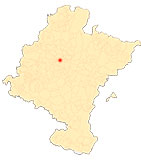pathway Teresian in Pamplona
Altarpiece of St. Teresa of the Discalced Carmelites
The altarpiece of Santa Teresa de los Descalzos was made, together with the sculpture of its owner, at the same time as the main altarpiece and the collateral altarpieces of the church, around 1670. Subsequently, the chapel in which it is located, then with its grille, was acquired by Don Marcos de Echauri, royal secretary and of the Royal committee of Navarra and benefactor of the convent, in 1689, which was adorned with coats of arms, lamps and other prizes. He also gilded the altarpiece at his own expense, commissioning it in 1690, as attested by a long registration on the bench of the altarpiece. With some modifications to place a pedestal for the saint, in 1922, the piece has survived to this day with its original structure, so often repeated in numerous altarpieces of the time, with a bench, a single body and a semicircular attic.
The beautiful image of the saint is life-size and follows the model popularized years ago by Gregorio Fernández in the sculpture of Carmen Calzado in Valladolid. It shows a snapshot of the saint writing under the inspiration of the Paraclete, with an ecstatic face and an elevated gaze. She wears the habit of the order with high waist and folded pleats so characteristic of the Castilian school. Its polychrome belongs to the time of the gilding of the altarpiece, appreciating a marked contrast between the light areas: semi-glossy incarnations of face and hands and ivory mantle -currently repainted-, and the dark Carmelite habit. The tunic and the scapular are variegated with geometric vegetal motifs, sgraffito imitating brocades. On the mantle the decoration is limited, as on other occasions, to a border of engraved scrolls that has been preserved practically intact.
-
FERNÁNDEZ GRACIA, R., "El convento e iglesia de los Carmelitas Descalzos de Pamplona. Architecture", Príncipe de Viana, 164, 1981, pp. 787-818.
-
ECHEVERRÍA GOÑI, P. and FERNÁNDEZ GRACIA, R., "El convento e iglesia de los carmelitas descalzos de Pamplona. Exorno artístico", Príncipe de Viana, 164, 1981, pp. 819-891.
-
AZANZA LÓPEZ, J. J., Arquitectura Religiosa Barroca en Navarra, Pamplona, Government of Navarre, 1996.
-
FERNÁNDEZ GRACIA, R., El retablo barroco en Navarra, Pamplona, Government of Navarre, 2003.
-
FERNÁNDEZ GRACIA, R., The Immaculate Conception in Navarre. Art and devotion during the centuries of the Baroque Mentors, artists and iconography. Pamplona, Eunsa, 2004.
-
FERNÁNDEZ GRACIA, R., Engraving, Counter-Reformation and Teresian Carmel. The collection of engravings of the Discalced Carmelites of Pamplona and Leonor de la Misericordia (Ayanz and Beaumont). Pamplona, I. G. Castuera, 2004.
-
FERNÁNDEZ GRACIA, R., "Santa Teresa", Juan de Goyeneche y el triunfo de los navarros en la Monarquía Hispánica del siglo XVIII, Pamplona, Fundación Caja Navarra, 2005, p. 352.
-
FERNÁNDEZ GRACIA, R., "Algunas esculturas napolitanas en Navarra", Pulchrum. Scripta in honorem Mª Concepción García Gainza, Pamplona, Government of Navarre, department de Cultura y Turismo-Institución Príncipe de Viana, 2011, pp. 300-310.
-
TARIFA CASTILLA, M. J., "Aparición de Cristo a Santa Teresa", Pamplona y San Cernin 1611-2011. IV Centenary of the Vow of the City, Pamplona, Pamplona City Council, 2011, p. 176.












